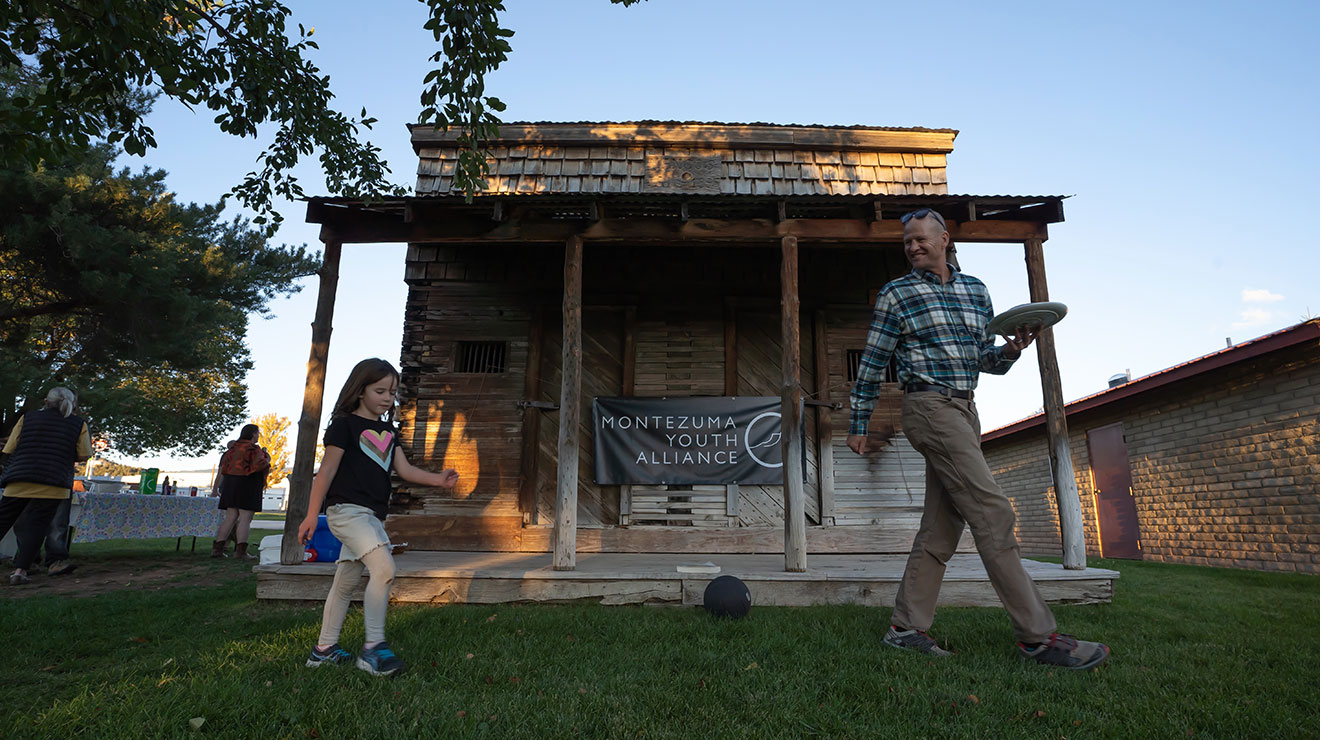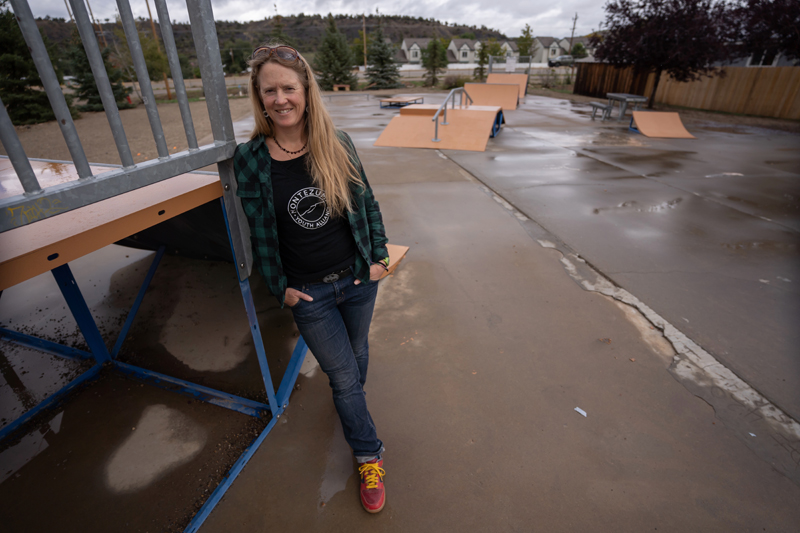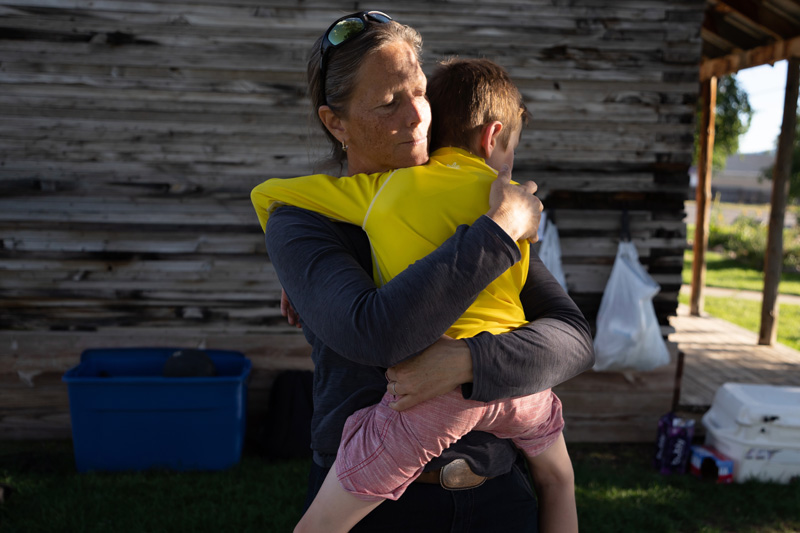
Organizations like Montezuma Youth Alliance are working to improve engagement, connectedness and a sense of well-being for young people in this southwest Colorado community.
Photos by Shannon Mullane
Organizations like Montezuma Youth Alliance are working to improve engagement, connectedness and a sense of well-being for young people in this southwest Colorado community.
Photos by Shannon Mullane
It’s the last full week of summer vacation for students in Mancos, a town between Durango and Cortez in southwest Colorado, and the industrious sounds at the skateboard park are coming from steel blades scraping pea gravel into plastic buckets.
The stones are a nuisance. Someone might be scattering them on the concrete surface to discourage use of the park. Whether on purpose or not, the gravel is unfriendly to the polyurethane wheels of a skateboard—and its rider.
A crew of teenagers wields shovels, brooms and wheelbarrows. They stop occasionally to graze from a smorgasbord of pizzas, chips and fresh fruit. It’s late afternoon. Lightning flashes form thick clouds over Mesa Verde National Park.
The students are led by the youthful Jorie McCann. McCann wears jean shorts and a green T-shirt with a logo for the Montezuma Youth Alliance.
The work at the skateboard park is part of the community’s multi-faceted effort to connect with Mancos youth. It’s about youth engagement. And it’s about eradicating the proverbial cracks where youth lose touch and don’t feel wanted.
“It’s about the kids who have a hard time at home,” said McCann. “It’s for the kids who are in that place of, ‘I don’t know why I’m coming to school—these people don’t care about me.’ They are not feeling supported.”

Jorie McCann at the skate park in Mancos.
In late July 2021, a 15-year-old Mancos boy died by suicide. The population of Mancos is just over 1,000; any such loss can hit a small community hard.
But it wasn’t the first such recent heartbreak. Thirteen months prior, a 17-year-old boy also died by suicide.
As reported by the Colorado Health Institute, Colorado has a higher prevalence of mental health issues and lower rates of access to mental health care when compared to other states. A 2021 Mental Health America report ranked Colorado 47th out of 50 states and the District of Columbia, based on 15 measures of mental health and substance use prevalence among adults and youth as well as access to care. (2022 data shows significant improvement for youth, though the same report now ranks Colorado last in the country for adult mental health.)
The 2021 death in Mancos sparked a movement. And organization. A poster went up immediately all over town: “Our community has been affected by suicide,” it read. “Let’s talk.” The poster invited the community to a meeting a few days after the youth’s death.
A number of key people ensured that talk converted itself to action. And one common theme emerged almost immediately: youth would drive the conversation and adults would listen to their choices and desires.
One key was Jorie McCann’s work with Montezuma Youth Alliance, which was already up and running in the summer of 2021. Following the suicide, Montezuma Youth Alliance put together the Mancos Wellbeing Project—”Connection prevents suicide. So we do stuff that increases connection in our community. That’s it,” the alliance website says succinctly of the program—and started working in collaboration with the SAFE (Suicide Awareness for Everyone) Coalition, based in Dolores and Montezuma counties. McCann had connections to people as well as to businesses, such as local Zuma Natural Foods that donated food to help attract youth to gatherings.
Another key person was Katie McClure. Before moving to Mancos three years ago, McClure had spent years as a health care executive in Oregon. She had led Oregon’s Healthiest State Campaign. She was keenly familiar with a groundbreaking study, conducted from 1995-97 by the Centers for Disease Control and Prevention and Kaiser Permanente, that found a scientific link between childhood traumas and adult chronic disease, incarceration and employment struggles. Most importantly, McClure was raised with the belief that helping others is what you do.
Last summer, days prior to the second youth suicide, McClure had scheduled a presentation at Mancos Public Library to share her insights on suicide prevention. Twenty-seven people gathered in the library’s community room. When asked via survey whether they would like to learn more and how, 10 of the 27 asked to learn quickly and hold a “multiday” conversation.
McClure is now executive director of Mancos United, an organization that emerged in September 2021. McClure has a 14-member board and, for the next three years, a $40,000 commitment from Mancos Schools. Mancos United emphasizes connections to bring social, emotional and mental well-being to all of Mancos Valley.
McClure is pursuing youth-identified projects, such as starting a podcast to discuss mental health. This summer, a local artist and the school’s art teacher worked with students who wanted to start a zine for self-expression. There are discussions to start a culinary project, or maybe a student-run café. Mancos United is dreaming up a summer “hub” for 2023 that would offer sports and arts programming or coordinate with a local woodworking studio (Turning Wild Studio and School) or the Mancos Collective, a downtown space that offers art, dance, music and yoga.
McClure is aware that while propping up programs is one thing, ensuring participation is another. Youth may be expected to care for younger siblings while a parent (or parents) work. A family might be struggling with basics like food, water and shelter and not how best to enrich their children’s lives. There are transportation challenges, too. McClure wants the group’s work to come across as unofficial and grassroots so it’s as welcoming as possible.
Every other week, free potlucks at Boyle Park in Mancos give McCann and others a chance to check in with youth. The food is strategically located along the walking route that kids would normally take to the Conoco and its convenience store snacks.
“I don’t want the youth to be left out,” said 16-year-old Nicolai Charley during a break in a pick-up basketball game at a recent potluck. Charley is a junior at Mancos High School and plans to attend Fort Lewis College to study mechanical engineering.
This is Charley’s second time living in Mancos. He’s noticed improvements. “The Mancos Wellbeing Project will have an impact on our community and will be able to engage more youth and I think that’s good.” It will work, he adds, “if we just make [youth] more comfortable being around adults and have more opportunities to build skills and knowledge.”

Nicolai Charley and Damon Starr, both students at Mancos High School, play basketball during a Mancos Wellbeing Project potluck on Sept. 15 at Boyle Park in Mancos.
Another key parent in organizing the town’s response was Breeah Kinsella. Kinsella lost her husband to substance abuse and suicide in 2012, when she was living in nearby Durango. Kinsella said the loss of her husband served as the catalyst to take a job with Celebrating Healthy Communities in 2016. Ultimately, she became executive director of the organization, which works across five counties in southwest Colorado on suicide prevention and substance abuse issues.
Kinsella says the combination of programming and community engagement are “absolutely amazing.” Such efforts, which might equally engage youth with healthy outlooks on life and also those who are struggling, help reduce risk and increase protection for everyone. Risk factors include lack of access to food and housing, and lack of a connection to school and community.
The American Academy of Pediatrics and the Centers for Disease Control and Prevention cite a number of factors contributing to youth suicide—individual factors such as social isolation and substance abuse, relationship factors such as adverse childhood experiences and family conflict, and community factors such as barriers to health care and stigma around seeking mental health care.
Community-wide strategies for reducing risk of youth suicide are manifold. The American Academy of Pediatrics emphasizes the importance of “cross-sectoral partnerships” in youth suicide prevention initiatives and underscores the importance of “reaching out to a broad array of participants in the life of a child and incorporating them into the care provided.”
“We have got to start addressing housing costs, we have got to start addressing employment and wages. We have to address food and water. We have got to start addressing why our state keeps catching on fire, because these are all stresses that increase risk,” said Kinsella.
The 2021 teen suicide, said Kinsella, prompted her to move to Denver with her 14-year-old daughter to take a job with the Colorado Providers Association, a statewide organization working to improve equitable access to anyone with substance use disorders and related behavioral health needs including the “full continuum” of prevention, treatment and recovery. From her first year in Denver, Kinsella said the state should make rural health care a higher priority, particularly around mental health. Communities such as Mancos, she said, have to step up for themselves and invest in local solutions.
Mancos School District Superintendent Todd Cordrey said the school district’s commitment to the nonprofit Mancos United is part of that effort to step up for its students. And the school district, which has only 40 staff positions devoted to teaching and instruction, this year designated one full-time employee to work with individual students and their social-emotional needs.
That employee is Brad Higinbotham, who took the position in Mancos after 21 years at Southwest Open School in nearby Cortez. In his first two weeks on the job, Higinbotham said his focus is on working to build trust with students on an individual basis. Schools, he said, need to do more to acknowledge that four-wall classrooms may not be a great match for young adults who want to be active and physical. He is encouraged by Mancos High School’s focus on careers, project-based learning, and helping students gain exposure to real-world work.
At Southwest Open School, said Higinbotham, teaching social and emotional skills was purposeful. Students are taught how to resolve conflicts, he said, and to help create a welcoming environment.
“It doesn’t matter what they look like, who they are, they feel accepted,” said Higinbotham. “I believe that’s really important.” In his 21 years at the school, said Higinbotham, there was not one suicide.
Mancos School District, for the first time, put aside $40,500 and made it available for students who need clinical counseling. The counseling is provided through Southwest Medical Group or The Grief Center of Southwest Colorado. Superintendent Cordrey said the money is being used at a steady clip and will likely be exhausted. If so, he said, he will find more.
Mancos schools are in session Monday through Thursday only. Teachers meet on Fridays and discuss individual student needs. During those discussions, the teachers might suggest that Higinbotham connect with a student and find out if there are any family or home life issues that could be given some support.
Mancos schools are starting an outdoor club with a state 21st Century Community Learning Center grant. The programming plans include hiking, mountain biking, animal tracking and wilderness skills. Ed Whritner, who is principal for both the middle and high schools, said the key is to remain student-centered. The activities have to be accessible, said Whritner; a mountain hike might be a 15-minute drive away, but it does no good if you can’t get there.
“The kids know what they want,” said Whritner. “Well-intentioned” adults typically think a mentorship program is what’s needed, Whritner added, but such programs are often “dead in the water” before they even start. That sends the wrong message, he said, because “they make the kids feel that they need help.” The key, he emphasized, is listening to youth needs.
Around Mancos, opportunities are expanding. On Nov. 11 of last year, the Mancos town hall was packed with youth who took turns voting for activities and infrastructure improvements. This was the night the skate park improvements came into focus, leading Jorie McCann to track down $9,000 in grants from United Way of Southwest Colorado. Students are also involved in the town’s planning for its parks.
McCann runs a weekly “Reading Buddies” program (on Fridays, when there is no school) that encourages older students to read to younger ones. She typically gets 15-20 takers. McCann is determined to help the Mancos schools keep reading skills for students on grade level. Achievement levels for non-readers are well-known and they are grim. A 2011 John Hopkins University study found that children who can’t read on grade level by 3rd grade are four times less likely to graduate from high school by age 19 than a child who reads proficiently by that time.
For McCann, the key is engagement. And activity. To that end, a local teacher has offered to let youth artists use one side of her large garage as a canvas. McCann is developing plans for public art around or integrated with the skate park. She has dreams of buying a bus to help with transportation. McCann applies for grants to help her piece together her $20,000 salary, plus a modest budget to put out food for the potlucks, the Reading Buddies gatherings, and when she’s got projects like the skate park renovation.
Follow McCann around town for an hour or two and she is constantly bumping into community members who have offered various equipment, spaces or opportunities. The key, say all those involved in the myriad efforts, is to continue to listen to and recognize the circumstances facing today’s youth.
Out at the skate park, two friends take turns on a quarter-pipe in between helping sweep pea gravel from the concrete. Hayden Anderson has only been skateboarding for a few weeks. He’s working on perfecting a “fakie front side” trick. Anderson and his pal Logan Hawkins are both about to start their junior year at Mancos High School.
Anderson is planning on studying kinesiology in college and wants to be a personal trainer. Hawkins isn’t so sure. Maybe trade school. Maybe welding.
“You hear their stories—and I’m not just talking about the kids that I’m going to be meeting with, but kids that I’ve been working with forever that are doing great in school and have good attitudes and they’re pretty productive,” said Higinbotham. “They have these crazy stories and I think a lot of us—the ones who read newspapers, get involved in politics, and pay attention to the community—we have no idea what the experience would be like when you are saddled with how to help your family, when you are told to take care of yourself, and go to school and finish school, graduate and be somebody in the world and all of those different pressures. We have no idea.”

Katie McClure, executive director of Mancos United, holds her 6-year-old son Clive during the community potluck.